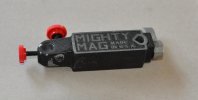It's taken me a couple of days to reply to my original post, but the responses have been most helpful to me.
I finally resorted to stopping by Harbor Freight and picking up two magnets. One is the red welder's magnet that Shane_o-co mentioned above, and the second is a 150 lb retrieval magnet. After a bit of use, I think I like the red welder's magnet. I found that both of these magnets have the actual magnets recessed into the metal bodies of the assemblies. This helps to keep temperatures down, and allows easy cooling when dunked in a bucket of water.
My application needs are for flattening blades immediately after they have been profiled. This builds a large amount of heat when I'm trying to get the last life from older 36 and 60 grit belts.
I considered fastening magnetic disks into multiple counter-bored holes down the length of a metal flat bar. My research showed that the old stye Alnico magnets are good for temperatures above 900F, but they are fairly brittle and I couldn't find them with countersunk holes which would allow them to be fastened to the bar with flat head cap screws. Samarian Colbalt magnets are good for temperatures in excess of 400F but they are expensive and also are not available as countersunk disks. The new and popular Neodymium magnets can permanently loose magnetic strength if heated above about 300F.
Anyway, thanks to all.







